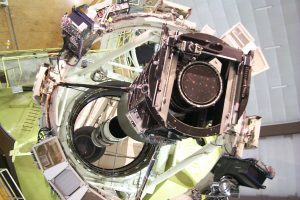One of the shortcomings of the first redshift surveys undertaken in the 1980s was the amount of telescope time that was needed to acquire the data. Spectra might take an hour each to obtain, so that measuring the redshifts of even a few thousand galaxies could require months or even years of observations.

The 2dF mounted on the Anglo-Australian Telescope. This view is looking down the body of the telescope to the 3.9-metre diameter primary mirror. Light collected by this mirror is reflected back up to the 2dF instrument, which is the large cylindrical apparatus in the foreground. The robot positions fibres at one end of the cylinder while light from the telescope is collected in the fibres at the other, and the whole apparatus then rotates around to swap over the fibres in use. (Image courtesy of the 2dFGRS Team).
The solution was to obtain many spectra simultaneously by collecting the light from lots of galaxies within the telescope’s field of view, splitting each one’s light into a separate spectrum, and recording it. The Two Degree Field (“2dF”) system on the 3.9-metre Anglo-Australian Telescope in Siding Springs, Australia, has been designed for exactly this process. A robot positions 400 fibre-optic cables in the focal plane of the telescope to collect light from hundreds of galaxies simultaneously, and these fibres then channel the light into spectrographs, which record a spectrum for each observed galaxy. It can take the robot an hour to carefully position all the fibres, but no time is wasted waiting for it: the system has two complete sets of fibres, so while one set is being used to collect spectra of galaxies, the other set is being positioned ready for the next observation. Using this equipment, astronomers have been able to construct a three-dimensional map of the positions of more than 200,000 galaxies.
